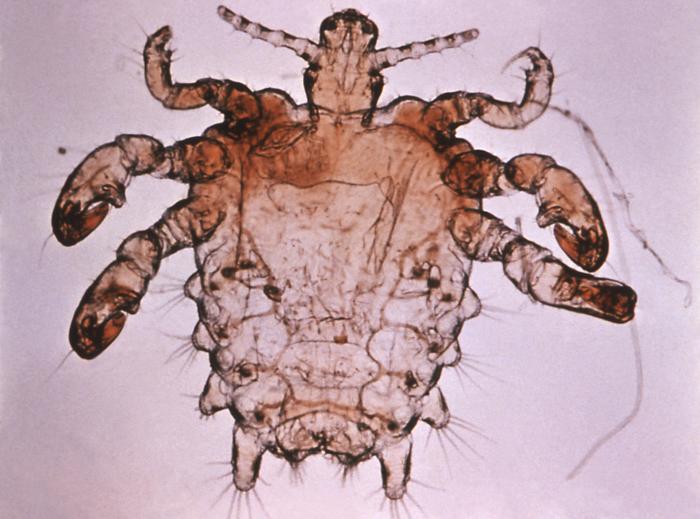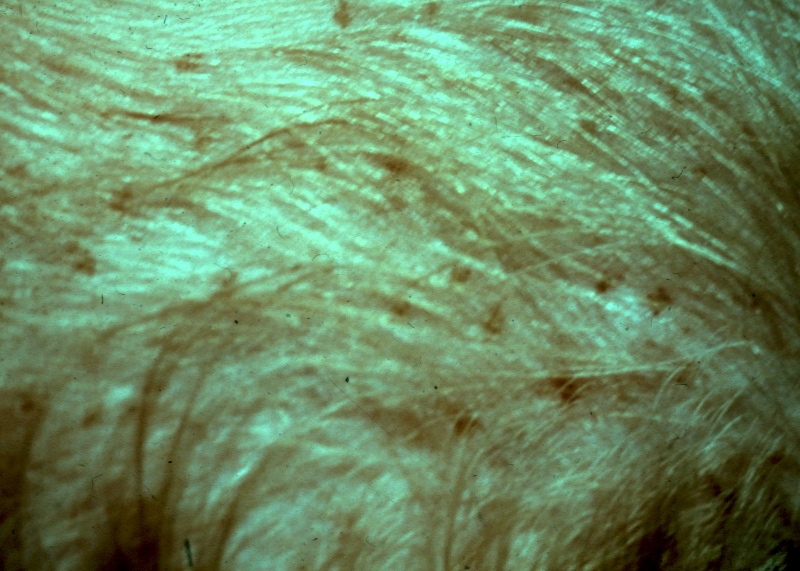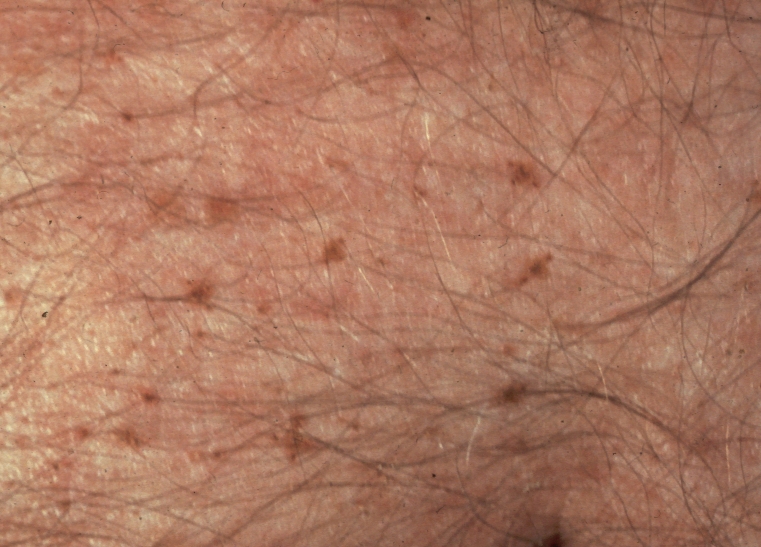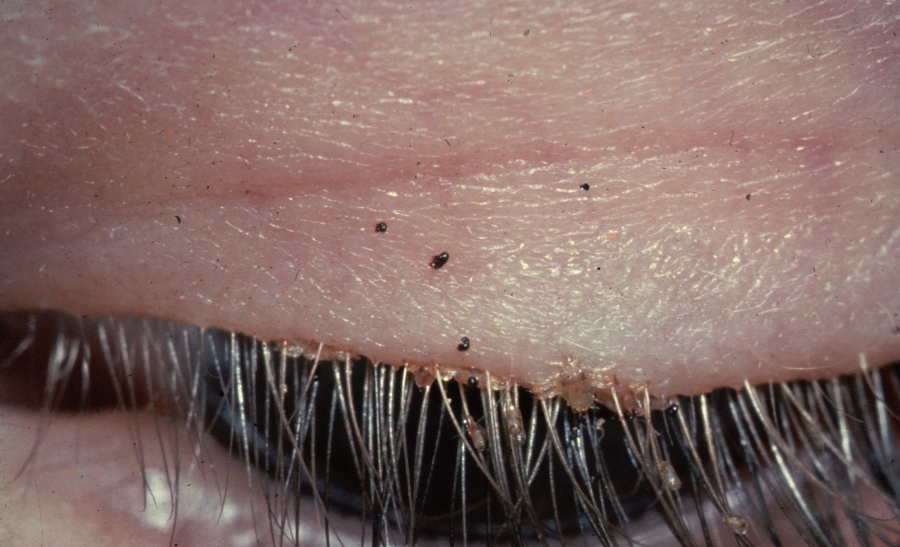Pediculus pubis
| Phthirus | ||
 | ||
|---|---|---|
| A magnified crab louse | ||
| ICD-10 | B85 | |
| ICD-9 | 132 | |
| DiseasesDB | 10028 | |
| MedlinePlus | 000841 | |
| eMedicine | emerg/298 | |
| MeSH | B01.500.131.617.564.159.730 | |
| Pubic louse or "Crabs" | ||||||||||||||||
|---|---|---|---|---|---|---|---|---|---|---|---|---|---|---|---|---|
 | ||||||||||||||||
| Scientific classification | ||||||||||||||||
| ||||||||||||||||
| Binomial name | ||||||||||||||||
| Pthirus pubis (L., 1758, originally Pediculus pubis) |
|
WikiDoc Resources for Pediculus pubis |
|
Articles |
|---|
|
Most recent articles on Pediculus pubis Most cited articles on Pediculus pubis |
|
Media |
|
Powerpoint slides on Pediculus pubis |
|
Evidence Based Medicine |
|
Clinical Trials |
|
Ongoing Trials on Pediculus pubis at Clinical Trials.gov Trial results on Pediculus pubis Clinical Trials on Pediculus pubis at Google
|
|
Guidelines / Policies / Govt |
|
US National Guidelines Clearinghouse on Pediculus pubis NICE Guidance on Pediculus pubis
|
|
Books |
|
News |
|
Commentary |
|
Definitions |
|
Patient Resources / Community |
|
Patient resources on Pediculus pubis Discussion groups on Pediculus pubis Patient Handouts on Pediculus pubis Directions to Hospitals Treating Pediculus pubis Risk calculators and risk factors for Pediculus pubis
|
|
Healthcare Provider Resources |
|
Causes & Risk Factors for Pediculus pubis |
|
Continuing Medical Education (CME) |
|
International |
|
|
|
Business |
|
Experimental / Informatics |
Editor-In-Chief: C. Michael Gibson, M.S., M.D. [1]
Description
The pubic or crab louse (Phthirus pubis) is a parasitic insect which spends its entire life on human hair and feeds exclusively on blood. Humans are the only known host of this parasite. Humans can also be infested with body lice (Pediculus humanus humanus) and with head lice (Pediculus humanus capitis)
Morphology
The dorso-ventrally flattened body of the louse is divided into head, thorax and abdomen. A pair of eyes and a pair of antenna are clearly visible on the head. The mouthparts are adapted to piercing the skin and sucking blood. The second and third pair of legs, with their terminal claws are adapted to holding the hair-shaft, while the first pair of leg holds the skin during feeding. Abdominal protuberances on the side of the body are characteristic of this species. Males are slightly smaller than females. The eggs are oval-shaped and ca. 0.8 mm in length. Immediately after oviposition they are shiny, round, and transparent. Pubic lice are 1-2- mm in size, varying according to the stage of their development. They are usually whitish-grayish in color they become reddish-brown for some time after blood-meal.
Biology
Pubic lice are insect parasites, spending their entire life on the host's hair and skin and feeding exclusively on blood, 4-5 times daily. The life-cycle from egg to adult is 22-27 days. The egg hatches producing the first nymphal stage, which after three moltings develops to nymph 2, nymph 3 and subsequently to either a male or female louse. The incubation period of the egg is 7-8 days, while the rest of the cycle is taken up with the development of nymphal stages. The average adult female lives for 17 and the male for 22 days. [1] [2].
Epidemiology
Pubic lice usually infest a new host only by close contact between individuals, making sexual contacts among adults and parent child interactions the more likely routes of infestation than shared towels, clothing, beds or closets. Adults are more frequently infested than children [3].
Diagnosis
A pubic louse infestation is usually diagnosed by carefully examining pubic hair for nits, nymphs and adults. Lice and nits could be removed either with forceps or by cutting the infested hair with scissors (with the exception of the eye area). A magnifying glass or a stereo-microscope can be used for the exact identification. If lice are detected in one family member, the entire family needs to be checked and only those who are infested with living lice should be treated.
Clinical Information
Although any part of the body may be colonized, crab lice favor the hairs of the genital (Fig. 1) and peri-anal region. Especially in male patients, pubic lice and eggs can also be found in hair on the abdomen (Fig. 2) and under the armpits as well as on the beard and mustache, while in children they are usually found in eye-lashes (Fig. 3). Infestation with pubic lice is called Phthiriasis or Pediculosis pubis, while infestation of eye-lashes with pubic lice is called Phthriasis palpebrarum [4]. The main symptom is itching, usually in the pubic hair area. It results from hypersensitivity to louse saliva, and it becomes strong enough 2 or more weeks following initial infestation. In the majority of infestations a characteristic grey-blue or slate coloration appears (maculae caeruleae) at the feeding site, which may last for days and is also characteristic for the infestation. Pubic lice are primarily spread through sweat and body odour contact or sexual contact. Therefore, all partners with whom the patient has had sexual contact within the previous 30 days should be evaluated and treated, and sexual contact should be avoided until all partners have successfully completed treatment and are thought to be cured. Because of the strong association between the presence of pubic lice and classic sexually transmitted diseases (STD), patients diagnosed with pubic lice should undergo evaluation for other STDs. Infection in a young child or teenager may indicate sexual abuse [5][6].
-
Fig.1 Pubic lice in genital area
-
Fig.2 Pubic lice in abdomen
-
Fig.3 Pubic lice on eye-lashes
References
- ↑ Nuttall GHF. 1918. The biology of Phthirus pubis. Parasitology 10: 383-405.
- ↑ Payot F. 1920. Contribution a l'etude du Phthirus pubis (Linne, Leach). Bull. Soc. vaud. Sci. nat. 53: 127-161.
- ↑ Alexander, J.O’D. 1984. Arhtropods and Human Skin. Springer-Verlag, Berlin
- ↑ Manjunatha NP, Jayamanne GR, Desai SP, Moss TR, Lalik J, Woodland A. Pediculosis pubis: presentation to ophthalmologist as pthriasis palpebrarum associated with corneal epithelial keratitis. Int. J. STD AIDS 2006; 17: 424-426
- ↑ Klaus S, Shvil Y, Mumcuoglu KY. Generalized infestation of a 3 1/2-year-old girl with the pubic louse. Pediatr Dermatol. 1994; 11: 26-28.
- ↑ Varela JA, Otero L, Espinosa E, Sánchez C, Junquera ML, Vázquez F. Phthirus pubis in a sexually transmitted diseases unit: a study of 14 years. Sex. Transm. Dis. 2003; 30: 292-296.
Evolutionary theory of origin
The most recent genetic research indicates that crab lice are related to the louse endemic to gorillas, Pthirus gorillae, having spread to early hominids from the ancestors of gorillas several millions of years ago, rather than having diverged from human head lice as was previously generally thought.[1]


